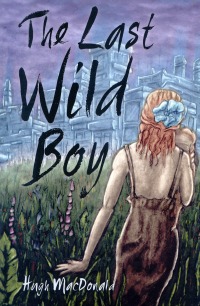| ________________
CM . . .
. Volume XX Number 34. . . .May 2, 2014
excerpt:
Hugh MacDonald, poet laureate of Prince Edward Island, has applied his craft and created an elegant concept novel that deals with issues of constructed gender and sexual identities. The novel is a speculative look at a future world where women (the Insiders) have inherited, or taken, the Earth for themselves, and the men (the Outsiders) have been eradicated everywhere except just beyond the walls of Aahimsa. The Outsiders exist, under close watch and equipped with explosive tracking devices, only because they are better labourers than clones. Heterosexual love and the yearning to be with a member of the opposite sex has been all but stamped out. Conception is synthetic and controlled so that all babies are female, while, birthmothering, in a manner very similar to Lois Lowry's The Giver, is a lowly job. With the goal of cultivating a society of independent women, babies are raised in childhood care centres to prevent women from bonding too deeply with their daughters. Women form partnerships with other women to fulfill the natural desire for companionship and to create stable homes to raise the daughters of this future civilization. The tale begins with Mabon, an outsider male soldier who is being punished for being overly kind and friendly. He must clear the carcasses of the birds and animals that fall victim to the electronic protective wall of Aahimsa. When his tracking device breaks and he discovers a woman lying on the ground just beyond the walls of Aahimsa, his life is changed forever. He is hesitant to help the insider as he knows it is against the law to speak to, look at or touch a female, but he can't resist her calls for help. He helps the woman and, just before she dies, he promises that he will look after her baby if he can. Now, though he is free from the gaze of the Insiders, it is only a matter of time before the Insiders, who will blame him for the woman's death, hunt him down and exterminate him. The story then jumps to Nora, who, with her partner Alice, discovers an Outsider baby named Adam. Nora has an immediate attachment to the child, and even though she discovers that he is an Outsider, she is unwilling to let him go. She makes the decision to abandon everything she knows in Aahimsa, including Alice, to try and save Adam. She tunnels beyond the walls of Aahimsa and into the wild where her and Adam's fate intertwine with Mabon's. Adam must be protected because he is the last male who can procreate naturally, and the Insiders see him as a threat to their entire society. The Last Wild Boy is rich with conversation topics addressing morality issues such as cloning, labour and gender equality, raising political questions surrounding governance and the implications of war and killing. The central focus of the book lies in the cultural constructions of gender and sexuality. MacDonald's text interrogates whether or not heterosexuality, or any sexuality, is a natural instinct or something learned and enforced. He questions the need for a divide between the genders and creates male characters that are refreshingly and realistically gentle, while the women take on the antagonistic roles, like Alice, who is unwilling to question the structure of her society, and her mother, who is the leader of Aahimsa and, therefore, responsible for the pursuit of Adam and Mabon. While the men are portrayed as the faultless victims in the novel's present day, Nora, the heroin of the text, must constantly battle with her own anger over the historical cruelty that women of Earth have endured. There is true bitterness in Nora and a sense of injustice over the centuries of oppression at the hands of men that can be used to justify the battle between the sexes that led to this speculative future. The book is told in an unusual narrative fashion, in a close third person that jumps between the three primary characters: Mabon, Nora and Alice. The descriptions are, in Hugh MacDonald fashion, poetic, rife with vivid imagery and description. The Last Wild Boy reads like a prequel, as though it is setting the stage for the story of Adam as he learns to negotiate the terms of this divided world and take on the burden of hope for a better, more equal future. This book calls for a more sophisticated reader as the story is speculative and quite complex. It is not meant to portray a future that is realistic but instead a set of ideas that are meant to be questioned and engaged with. Recommended. Stephanie Dror is in the MA in Children's literature program at the School of Library and Archival Studies, the University of British Columbia.
To comment
on this title or this review, send mail to cm@umanitoba.ca.
Copyright © the Manitoba Library Association. Reproduction for personal
use is permitted only if this copyright notice is maintained. Any
other reproduction is prohibited without permission.
NEXT REVIEW |
TABLE OF CONTENTS FOR THIS ISSUE
- May 2, 2014.
AUTHORS |
TITLES |
MEDIA REVIEWS |
PROFILES |
BACK ISSUES |
SEARCH |
CMARCHIVE |
HOME |
